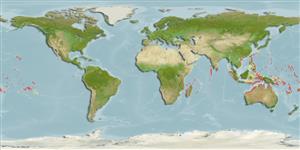Common names from other countries
Environment: milieu / climate zone / depth range / distribution range
Ecologia
. Tropical
Indo-West Pacific: Seychelles to Samoa.
Length at first maturity / Tamanho / Peso / Idade
Maturity: Lm ? range ? - ? cm
Supratidal and terrestrial (Refs. 8423, 97241). Intertidal (Ref. 106854). Commonly found in turban shells in offshore islands. Inhabits offshore islands. Nocturnal (Ref. 8423).
Life cycle and mating behavior
Maturidade | Reprodução | Desova | Ovos | Fecundidade | Larvas
Members of the order Decapoda are mostly gonochoric. Mating behavior: Precopulatory courtship ritual is common (through olfactory and tactile cues); usually indirect sperm transfer.
MarineSpecies.org. 2050. (Ref. 3477)
Status na Lista Vermelha da IUCN (Ref. 130435)
Status no CITES (Ref. 108899)
Not Evaluated
Not Evaluated
Perigo para os humanos
Harmless
Uso pelos humanos
| FishSource |
Ferramentas
Mais informação
Idade/Tamanho
Crescimento
Comprimento-peso
Comprimento-comprimento
Morfologia
Larvas
Abundância
Fontes da internet
Estimates based on models
Preferred temperature
(Ref.
115969): 25.5 - 29.3, mean 28.4 (based on 1545 cells).
